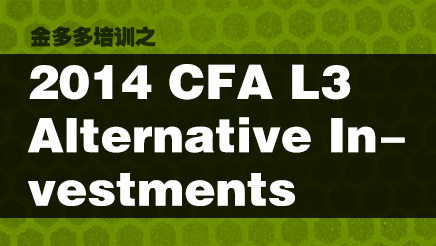课程章节按照官方的Los讲解
R26 Alternative Investments Portfolio Management【试听】本节只有1个reading故将所有考点列出!
The candidate should be able to:
a describe common features of alternative investments and their markets and how alternative investments may be grouped by the role they typically play in a portfolio;
b explain and justify the major due diligence checkpoints involved in selecting active managers of alternative investments;
c explain distinctive issues that alternative investments raise for investment advisers of private wealth clients;
d distinguish among the principal classes of alternative investments, including real estate, private equity, commodity investments, hedge funds, managed futures, buyout funds, infrastructure funds, and distressed securities;
e discuss the construction and interpretation of benchmarks and the problem of benchmark bias in alternative investment groups;
f evaluate the return enhancement and/or risk diversification effects of adding an alternative investment to a reference portfolio (for example, a portfolio invested solely in common equity and bonds);
g describe advantages and disadvantages of direct equity investments in real estate;
h discuss the major issuers and suppliers of venture capital, the stages through which private companies pass (seed stage through exit), the characteristic sources of financing at each stage, and the purpose of such financing;
i compare venture capital funds and buyout funds;
j discuss the use of convertible preferred stock in direct venture capital investment;
k explain the typical structure of a private equity fund, including the compensation to the fund’s sponsor (general partner) and typical timelines;
l discuss issues that must be addressed in formulating a private equity investment strategy;
m compare indirect and direct commodity investment;
n explain the three components of return for a commodity futures contract and the effect that an upward- or downward-sloping
term structure of futures prices will have on roll yield;
o describe the principle roles suggested for commodities in a portfolio and explain why some commodity classes may provide a better hedge against inflation than others;
p identify and explain the style classification of a hedge fund, given a description of its investment strategy;
q discuss the typical structure of a hedge fund, including the fee structure, and explain the rationale for high-water
mark provisions;
r describe the purpose and characteristics of fund-of- funds hedge funds;
s discuss concerns involved in hedge fund performance evaluation;
t describe trading strategies of managed futures programs and the role of managed futures in a portfolio;
u describe strategies and risks associated with investing in distressed securities;
v explain event risk, market liquidity risk, market risk, and “J-factor risk” in relation to investing in distressed securities.
该课程包括
视频讲解
几百页电子版讲义
对应考点总结
对应知识点脑图
学习方式
课程为video,下载到本地电脑观看
课程有效期
2014年6月考试结束后,课程到期
让您轻松掌握CFA3级,针对2014年考试大纲,结合CFA官方教程和kaplan notes取其精华。
如果您准备备战CFA3级,请加入我们!
如果您已经开始备战,自学有困难,请加入我们!
观看课程无需网络,适合全球考生学习!
英文讲义,中文讲解,抽丝剥茧解析,让难点没有死角!
电子版讲义,方便下载浏览!
视频课程观看次数不限,让您考试无忧!





